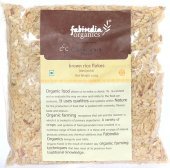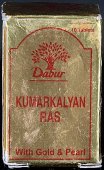Food: 5 definitions
Introduction:
Food means something in Buddhism, Pali, Hinduism, Sanskrit, Jainism, Prakrit, the history of ancient India. If you want to know the exact meaning, history, etymology or English translation of this term then check out the descriptions on this page. Add your comment or reference to a book if you want to contribute to this summary article.
Images (photo gallery)
(+7 more images available)
In Hinduism
Shaktism (Shakta philosophy)
Source: Brill: Śaivism and the Tantric Traditions (shaktism)Worship of food formed a part of the Navarātra Tantric ritual (an autumnal festival of the warrior goddess Caṇḍikā).—Worship of weapons with flowers, perfume and food, adapted from the pre-existing Vedic model of military festivities.—Various 5th century sources refer to rituals such as the worship of food, for example: Viṣṇudharmottarapurāṇa 2.158.6cd–7, Agnipurāṇa 267.13cd–16ab (repeating Viṣṇudharmottara); Varāhapurāṇa cited in the Kṛtyaratnākara, pp. 364–365.

Shakta (शाक्त, śākta) or Shaktism (śāktism) represents a tradition of Hinduism where the Goddess (Devi) is revered and worshipped. Shakta literature includes a range of scriptures, including various Agamas and Tantras, although its roots may be traced back to the Vedas.
Yoga (school of philosophy)
Source: ORA: Amanaska (king of all yogas): A Critical Edition and Annotated Translation by Jason BirchFood is denoted by the Sanskrit term Āhāra, according to the Dattātreyayogaśāstra 146-47 (Cf. Haṭhapradīpikā 3.79 and Śivasaṃhitā 3.36 and 5.7).—Accordingly, “The action called Viparīta [by which the body is inverted] destroys all diseases. For one who frequently practises it, their digestive fire increases. [That person] should certainly procure plenty of food (āhāra), O Sāṅkṛti, [because] if little food (alpa-āhāra) [is eaten], the digestive fire burns up [the body]”.

Yoga is originally considered a branch of Hindu philosophy (astika), but both ancient and modern Yoga combine the physical, mental and spiritual. Yoga teaches various physical techniques also known as āsanas (postures), used for various purposes (eg., meditation, contemplation, relaxation).
In Buddhism
General definition (in Buddhism)
Source: A Buddhist Library: In This Very LifeFood (i.e., the diet one finds personally appropriate) refers to one of the Seven types of Suitability, which should be met in order to create an environment that is supportive of meditation practice.—The fifth area of suitability, of food, means that the diet one finds personally appropriate is also supportive to progress in meditation. However, one must bear in mind that it is not always possible to fill one"s every preference. Group retreats can be quite large, and meals are cooked for every one at once. At such times, it is best to adopt an attitude of accepting whatever is served. If one"s meditation is disturbed by feelings of lack or distaste, it is all right to try to rectify this if convenient.
In Jainism
General definition (in Jainism)
Source: archive.org: TrisastisalakapurusacaritraFood is under certain conditions suitable for ascetics, according to chapter 1.1 [ādīśvara-caritra] of Hemacandra’s 11th century Triṣaṣṭiśalākāpuruṣacaritra: an ancient Sanskrit epic poem narrating the history and legends of sixty-three illustrious persons in Jainism. Accordingly, “[...] The Ācārya [Dharmaghoṣa] said [to Dhana], ‘Food, etc., which has not been made nor caused to be made, nor intended (for them) is suitable for ascetics. Water too that has come from tanks, wells, ponds, etc., is prohibited unless it is purified by some means, according to the teaching of the Jinas, O caravan-chief’.”
Also, the Sūri [Dharmaghoṣa] said, “[...] Food, etc., that has not been made, nor caused to be made, and is free from life, is suitable for us”. Dhana said, “I shall give to the sādhus only that which is suitable”; bowed, and went to his own abode. Then just behind him came two Sādhus, and by chance there was nothing, food, drink, etc., suitable for them. Searching here and there, the merchant himself saw some fresh ghee, pure as his own heart. “Here is something suitable”, the caravan-chief said. Saying, “I accept it”, the Sādhu held out his dish. Thinking, “I am blessed, I have done my duty, I am virtuous”, with the hair on his body erect from pleasure, he himself gave the ghee to the sādhu. After the gift of ghee had been made, Dhana paid homage to the Munis, making grow his bulb of merit, as it were, with the water of the tears of joy. They bestowed ‘dharmalābha’, equal to a perfect charm for the accomplishing of all happiness, and went to their retreat. At that time, by the power of his gift the seed of the tree of mokṣa, the seed of enlightenment, difficult to gain, was acquired by the merchant.

Jainism is an Indian religion of Dharma whose doctrine revolves around harmlessness (ahimsa) towards every living being. The two major branches (Digambara and Svetambara) of Jainism stimulate self-control (or, shramana, ‘self-reliance’) and spiritual development through a path of peace for the soul to progess to the ultimate goal.
India history and geography
Source: Singhi Jain Series: Ratnaprabha-suri’s Kuvalayamala-katha (history)Food (being begged) represents a scene of human life commonly depicted on the Saṃsāracakra paintings, in ancient India, as mentioned in the Kathās (narrative poems) such as Uddyotanasūri in his 8th-century Kuvalayamālā (a Prakrit Campū, similar to Kāvya poetry).—Page 185.21 f.: Here follows a description of a printed scroll illustrating the Jaina conception of saṃsāracakra. [...] The saṃsāra-cakra illustrated the three worlds of hell, human world and the world of gods. [For example:] An old man surrounded by his family; a beggar asking for food; a mendicant clothed in tattered garments.

The history of India traces the identification of countries, villages, towns and other regions of India, as well as mythology, zoology, royal dynasties, rulers, tribes, local festivities and traditions and regional languages. Ancient India enjoyed religious freedom and encourages the path of Dharma, a concept common to Buddhism, Hinduism, and Jainism.
See also (Relevant definitions)
Starts with: Food supply.
Ends with: Black snake food, Cooked food, Material Food, Raccoon food, Snake-food.
Full-text (+6936): Bhojana, Ahara, Anna, Annamaya, Annada, Kadanna, Anahara, Bhakshya, Asana, Annapana, Annadana, Ucchishta, Khadya, Bhojya, Nirahara, Abhyavahara, Prasada, Bhojaniya, Bhikshanna, Ghasa.
Relevant text
Search found 469 books and stories containing Food; (plurals include: Foods). You can also click to the full overview containing English textual excerpts. Below are direct links for the most relevant articles:
The Bhikkhus Rules (by Bhikkhu Ariyesako)
Begging For Food < [Chapter 3 - Possessions And Offerings]
Meal Time < [Chapter 3 - Possessions And Offerings]
Meal Invitations < [Chapter 3 - Possessions And Offerings]
Shrimad Bhagavad-gita (by Narayana Gosvami)
Verse 17.8 < [Chapter 17 - Śraddhā-traya-vibhāga-yoga]
Verse 15.14 < [Chapter 15 - Puruṣottama-toga (Yoga through understanding the Supreme Person)]
Verse 17.9 < [Chapter 17 - Śraddhā-traya-vibhāga-yoga]
The Patthanuddesa Dipani (by Mahathera Ledi Sayadaw)
Garga Samhita (English) (by Danavir Goswami)
Verse 3.1.25 < [Chapter 1 - The Worship of Śrī Girirāja]
Verses 4.1.26-27 < [Chapter 1 - The Story of the Personified Vedas]
Verse 5.24.59 < [Chapter 24 - The Killing of the Kola Demon]
The Markandeya Purana (Study) (by Chandamita Bhattacharya)
Vegetarian Food < [Chapter 2]
Food that are not to be Stolen < [Chapter 2]
Proper Food for Yogins < [Chapter 2]
Maha Prajnaparamita Sastra (by Gelongma Karma Migme Chödrön)
III. Material benefits granted by the Bodhisattva < [Part 2 - Fulfilling the wishes of all beings]
Story of the fabulous gifts of Bindu < [Part 2 - Fulfilling the wishes of all beings]
Story of the trick of the Kaśmirian < [Chapter XXIV - The Virtue of Patience]
Related products
(+250 more products available)











